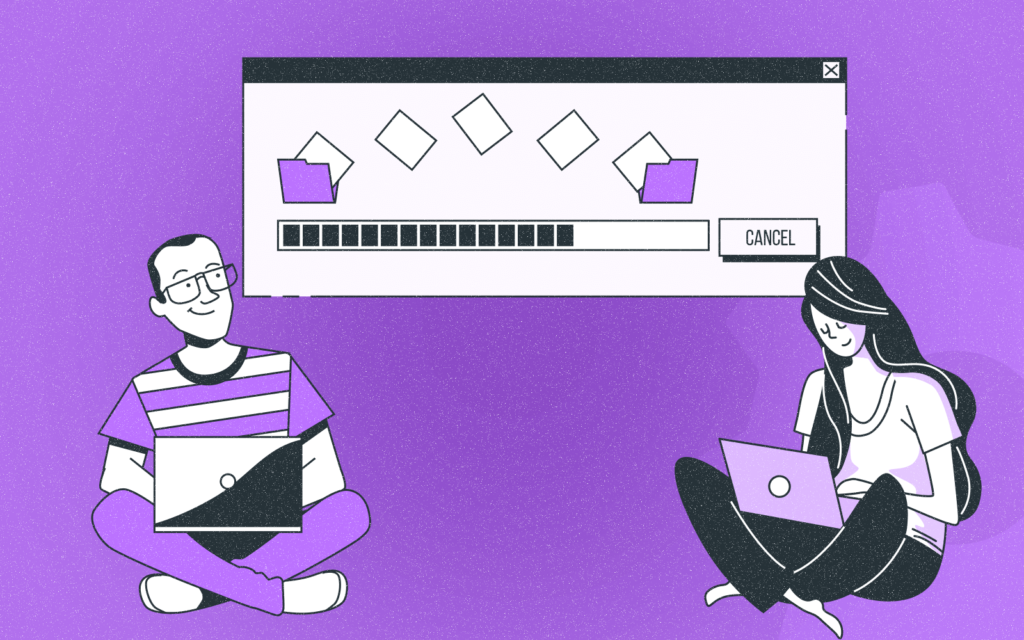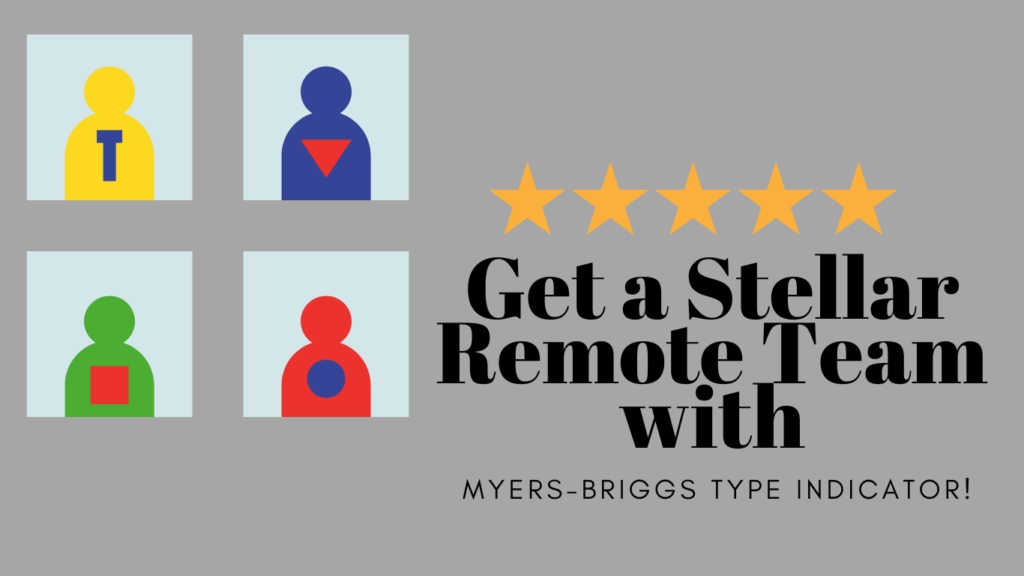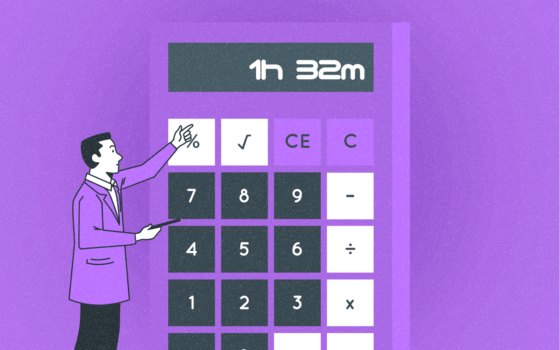Build Your Ideal Remote Team with Myers-Briggs Type Indicator

Remote work has become increasingly popular in recent years, bringing with it a whole new set of challenges for managers and team leaders. Building and managing a successful remote team requires a unique set of skills and strategies that differ from those used in traditional office environments. One tool that can be particularly helpful in this regard is the Myers-Briggs Type Indicator (MBTI), an assessment tool that can help you understand the personality types of your team members and how they work best.
The MBTI is a powerful tool that can help you build an ideal remote team by providing insight into the strengths and weaknesses of each team member. By understanding the different personality types on your team, you can create a more cohesive and effective team that works together seamlessly, even when they’re working from different locations. In this blog post, we’ll explore how the MBTI can help you build your ideal remote team, and provide tips and strategies for using this tool effectively. Keep reading!

Psychology is not set in stone. People come from different backgrounds, cultures and parenting styles. As well, people change over time! Yet, some of our essence remains intact and we can call that essence: personality. According to the Myers-Briggs Type Indicator (MBTI), personality is a set of innate preferences for how we perceive the world and make decisions.
How do you know yours? Hoop in! We are telling you.
How Personality Tests Work?
Personality tests aim to assess an individual’s unique set of characteristics, behaviors, and preferences. One of the most widely used personality tests is the Myers-Briggs Type Indicator (MBTI), which defines four major categories:
- Extraversion (E) vs Introversion (I)
- Sensing (S) vs (N) Intuition
- Thinking (T) vs (F) Feeling
- Judging (J) vs (P) Perceiving
These categories are used to create a personality profile that can help individuals gain a better understanding of themselves and others. These preferences combine to form 16 different personality types. The MBTI works by asking individuals a series of questions about their behavior, attitudes, and preferences.

Based on their answers, they are assigned a combination of four letters that define their personality type. For example, someone who is an introverted, intuitive, thinking and perceiving type would be labeled as an “INTP.” While the MBTI has been criticized for its lack of scientific validity, many people find it to be a useful tool for self-reflection and personal growth!
In fact, according to Psychology Today, around 80% of the 500 Fortune Companies use personality tests such as the MBTI to assess employees’ strengths and weaknesses. This is a good way to streamline talents!
Benefits of the Myers-Briggs Type Indicator (MBTI) in Remote Teams
Besides pointing out the best and the no-so-good of your team, using the Myers-Briggs Type Indicator (MBTI) to build a remote team can have several benefits:
- Improved communication: By understanding each team member’s personality type, communication can be tailored to their preferences, leading to more effective and clear communication.
- Enhanced teamwork: Knowing each team member’s strengths and weaknesses can help in assigning tasks and building a complementary team that works well together.
- Increased productivity: A better understanding of team members’ personalities can help identify areas where they might excel and be most productive.
- Reduced conflict: When team members understand each other’s communication styles and preferences, it can reduce misunderstandings and conflicts.
- Improved job satisfaction: By understanding each team member’s preferences, it is easier to assign tasks that align with their strengths and interests, leading to greater job satisfaction.
The MBTI can help build a more cohesive and effective remote team by leveraging the strengths and preferences of each team member, especially since the staff won’t be sharing a physical space.
Since we know it can be a bit confusing, and maybe you don’t even know where to start. Read below as to how to use this personality indicator to build the best remote team out there!
Get a Stellar Remote Team with Myers-Briggs Type Indicator
As we told you before, there are 16 possible combination and we have outlined them down below:
- ISTJ: practical, responsible, organized, and dependable
- ISFJ: caring, loyal, empathetic, and detail-oriented
- INFJ: insightful, intuitive, creative, and compassionate
- INTJ: analytical, strategic, independent, and visionary
- ISTP: spontaneous, curious, logical, and adaptable
- ISFP: sensitive, artistic, empathetic, and reserved
- INFP: idealistic, authentic, compassionate, and creative
- INTP: analytical, inventive, logical, and independent
- ESTP: energetic, confident, adaptable, and daring
- ESFP: fun-loving, sociable, spontaneous, and enthusiastic
- ENFP: enthusiastic, empathetic, curious, and creative
- ENTP: innovative, analytical, adaptable, and outspoken
- ESTJ: practical, decisive, responsible, and efficient
- ESFJ: friendly, practical, social, and organized
- ENFJ: charismatic, empathetic, idealistic, and organized
- ENTJ: strategic, confident, assertive, and ambitious
You don’t need a single one of them to make your remote team work; you just need to find the perfect mix.
Determine the Roles you Need to Fill
One of the great things about the MBTI is that it offers you “the roles” of each personality. For example, INTJ’s are called the “Architects.” Do you need someone that can “create” things by themselves with little to no supervision at all? Then, this one is your choice!
One famous “Architect” is Elon Musk. Here are some other examples:
- ISTJ (Introverted, Sensing, Thinking, Judging): The “Logistician” ISTJs are often detail-oriented and dependable, making them great candidates for roles that require a lot of structure and organization. They may excel in positions such as project management or quality control, where attention to detail is critical.
- ENFP (Extroverted, Intuitive, Feeling, Perceiving): The “Campaigner” ENFPs are often creative and enthusiastic, making them ideal for roles that involve brainstorming and idea generation. They may excel in positions such as marketing or business development, where their ability to think outside the box can lead to new opportunities.
- ISTP (Introverted, Sensing, Thinking, Perceiving): “The Crafter” ISTPs are often analytical and hands-on, making them great candidates for roles that involve problem-solving and troubleshooting. They may excel in positions such as IT support or engineering, where their ability to think critically and work with their hands is essential.
- ENFJ (Extroverted, Intuitive, Feeling, Judging): “The Protagonist” ENFJs are often empathetic and persuasive, making them ideal for roles that involve working with people. They may excel in positions such as human resources or customer service, where their ability to understand and connect with others can lead to positive outcomes.
Administer the Myers-Briggs Type Indicator Test
After getting familiar with the personalities and roles, it’s time to get your hands dirty! Get your employees or potential candidates to fill out the test. To administer the MBTI personality test, you can either hire a certified practitioner or use a certified online assessment tool. It’s important to ensure that the test is administered in a consistent and unbiased way to avoid any potential legal issues.
For example, let’s say you are building a remote marketing team and are looking for someone to handle the creative aspects of the job. You might administer the MBTI test to candidates to identify those who score high in the Intuition (N) and Feeling (F) categories, which are associated with creativity and empathy. By selecting someone with these personality traits, you can build a team that is well-rounded and can work together effectively.
Analyze the Results
To analyze MBTI results in an unbiased manner, it is important to always keep in mind the purpose of the assessment and the potential for bias. The MBTI is a tool designed to help individuals gain insight into their personality preferences and how they may impact their work style and communication with others. However, it should not be used as the sole determinant of job fit or potential for success.
To analyze MBTI results, it is important to:
- Consider each individual’s unique combination of preferences and how they may interact with the requirements of the job or team dynamics.
- Avoid making assumptions or stereotypes based on certain preferences, and instead focus on how these preferences can be leveraged to enhance performance and collaboration.
For example, if an employee has a preference for introversion, it may be helpful to consider how they can be given opportunities for quiet reflection and independent work, while also ensuring that they have opportunities for collaboration and communication with others.
Similarly, if an employee has a preference for thinking over feeling, it may be helpful to consider how they can be given opportunities to analyze data and make logical decisions, while also ensuring that they are able to consider the impact of their decisions on others.
Consider Team Dynamics
After analyzing the MBTI results, it’s important to consider the dynamics of your remote team and how different personality types will interact with one another. Understanding the strengths and weaknesses of each team member can help you build a more cohesive and effective team!
You can use this information to create better communication strategies. For example, if you have a team member who is an introvert, you may want to create opportunities for them to contribute their ideas without feeling overwhelmed or overlooked.
Here, you have a small image with some MBTI compatibility:

On the other hand, if you have a team member who is an extrovert, you may want to give them more opportunities to collaborate and brainstorm with the team. By taking into account the different personalities on your team, you can create a more inclusive and productive remote work environment.
Provide Team Training
Training your team on MBTI roles can be a valuable tool for improving team dynamics. By understanding their own personality types and those of their teammates, team members can learn how to better communicate and collaborate with each other. This can lead to increased productivity and job satisfaction.
MBTI personalities are a guideline, rather than a set verdict!
It’s important to remember that while MBTI roles can provide insight into how individuals may prefer to work, it’s not a definitive measure of their abilities or potential. With the right training and support, employees can learn to work outside their comfort zones and adapt their communication and work styles to better fit the needs of the team.
Encouraging a growth mindset and providing opportunities for skill development can help team members feel empowered to stretch them and contribute to the team in new and valuable ways.
Tailor Communication
Tailoring communication and management styles to each team member based on their personality type can lead to better understanding, stronger relationships, and improved productivity. By recognizing and adapting to individual differences, managers can create a more inclusive and positive work environment.
For example, some team members may prefer direct instructions and clear guidelines, while others may prefer more autonomy and creative freedom. Understanding these preferences can help managers assign tasks and provide feedback in a way that is most effective for each team member. Additionally, recognizing individual strengths and weaknesses can allow managers to assign tasks that align with each team member’s skills, leading to greater job satisfaction and better overall performance.
Bottomline
It’s worth noting that the MBTI test should not be used as the sole basis for building a remote team. While it can provide valuable insights into each employee’s personality type, it’s important to consider other factors as well, such as skills, experience, and cultural fit. By taking a holistic approach to building your remote team, you can create a group of individuals who work well together and are committed to achieving your organization’s goals.
It is important to use the results of the MBTI as a starting point for understanding team dynamics. Don’t limit your remote team! Effective communication, trust-building activities, and setting clear expectations are all essential components in building a high-functioning remote team. So, if you’re looking to build a remote team, consider the insights from the MBTI test, but also remember to incorporate other strategies and assessments to create a well-rounded approach.
We wish you luck on your quest to build your remote team.
-The Monitask Team


